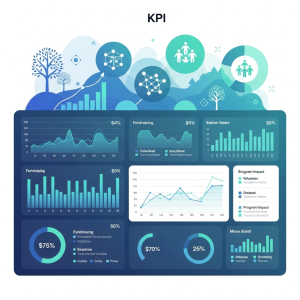Organizations across all industries are grappling with an ever-increasing volume and variety of information. To truly leverage this wealth of data for strategic insights and competitive advantage, a modern data architecture is essential. Enter the data lake: a powerful solution for housing and harnessing your organization’s most valuable asset – its data.
Understanding the Power of a Data Lake
Before diving into industry-specific applications, let’s understand the core concepts behind this transformative technology.
What is a Data Lake?
Imagine a vast, natural lake, capable of holding all types of water – rivers, streams, rainwater – in its raw, unfiltered form. A data lake operates similarly, serving as a centralized repository that allows you to store all your structured, semi-structured, and unstructured data at any scale. Unlike traditional databases or data warehouses, a data lake doesn’t require you to pre-define the structure of your data. It welcomes data in its native format, be it raw data from sensors, social media feeds, documents, images, or traditional databases. This flexibility allows for agile data exploration, advanced analytics, and the discovery of hidden patterns that might be missed with rigid, pre-defined structures.
The beauty of a data lake lies in its ability to empower data scientists and business analysts to access, explore, and analyze data in its most granular form. By removing the constraints of traditional data management systems, organizations can foster a culture of data-driven innovation, uncovering valuable insights that fuel better decision-making, new product development, and enhanced operational efficiency. This approach shifts the paradigm from data storage to data utilization, turning raw information into actionable intelligence.
In essence, a data lake provides a scalable and cost-effective platform for organizations to:
- Centralize data: Break down data silos and create a single source of truth.
- Embrace data variety: Store structured, semi-structured, and unstructured data in its native format.
- Enable data discovery: Facilitate exploration and analysis without rigid schema constraints.
- Support advanced analytics: Power machine learning, artificial intelligence, and big data initiatives.
Data lakes allow you to quickly access the data needed to improve your business processes. – Karl Oder, Director Data Engineering and Operations
Data Lake vs. Data Warehouse: Key Differences
While both data lakes and data warehouses are crucial components of a robust data strategy, they serve distinct purposes and operate with different philosophies. Understanding their key differences is essential to choosing the right solution for your specific needs.
| Feature | Data Lake | Data Warehouse |
| Data Structure | Schema-on-Read (structure applied during analysis) | Schema-on-Write (structure defined before storage) |
| Data Types | Structured, Semi-structured, Unstructured | Primarily Structured |
| Processing | Raw data stored, transformed as needed | Transformed, cleaned data stored |
| Schema | Flexible, evolving schema | Fixed, predefined schema |
| Purpose | Data exploration, discovery, advanced analytics | Reporting, business intelligence, known queries |
In short, think of a data warehouse as a curated library – organized and structured for specific, well-defined questions. A data lake, on the other hand, is more like an archive – vast and diverse, ready for exploration and discovery, allowing for a wider range of analytical possibilities.1
Data Lakes: Transforming Industries with Data-Driven Insights
The versatility of data lakes makes them invaluable across a multitude of industries. Let’s explore how a data lake strategy can revolutionize data utilization in Higher Education, Non-Profit, and Healthcare sectors.
Higher Education: Enhancing Student Success with Data Lakes and Student Data
For higher education institutions, understanding and optimizing student data is paramount to enhancing student success, improving program effectiveness, and ensuring institutional sustainability. A data lake provides the ideal environment to consolidate diverse student data points, ranging from enrollment demographics and academic performance to engagement metrics, financial aid information, and post-graduation career paths.
Working with Datatelligent to build our data lake has been transformative. We now have the flexibility to create the specific data views our teams need while upholding student privacy, and crucially, we can finally look back historically, day by day. This gives us the essential insights needed for building a sustainable future for enrollment management.
– Debbie Phelps, Executive Director of Institutional Effectiveness
By leveraging a data lake, colleges and universities can:
- Gain a Holistic View of the Student Journey: Integrate data from various systems – student information systems (SIS), learning management systems (LMS), CRM platforms, and alumni databases – to create a comprehensive picture of each student’s experience from admission to career placement.
- Personalize Student Support and Interventions: Identify at-risk students earlier by analyzing patterns in academic performance, engagement levels, and demographic factors, enabling proactive interventions and personalized support services.
- Optimize Curriculum and Program Offerings: Analyze program enrollment trends, student performance within specific programs, and post-graduation employment outcomes to refine curriculum, identify high-demand programs, and ensure alignment with industry needs.
- Improve Alumni Engagement and Fundraising: Understand alumni demographics, career trajectories, and engagement history to personalize outreach efforts, improve fundraising strategies, and build stronger alumni networks.
Imagine using a data lake to analyze how different academic programs impact student job placement rates and salary growth after graduation. This level of insight, powered by a robust data lake architecture, is transforming how higher education institutions operate and serve their students.
Non-Profit Organizations: Measuring and Maximizing Effectiveness Data with Data Lakes
Non-profit organizations are driven by a mission to create positive impact. To effectively achieve their goals and demonstrate their value to donors and stakeholders, non-profits need to rigorously measure their effectiveness. A data lake empowers non-profits to consolidate and analyze diverse effectiveness data – program participation metrics, demographic data of served populations, donor information, community impact indicators, and operational efficiency data.
With a data lake in place, non-profit organizations can:
- Quantify Program Impact and Outcomes: Track program participation, measure outcomes against defined goals, and identify areas for program improvement and optimization.
- Understand Beneficiary Needs and Demographics: Analyze demographic data of served populations to tailor programs to specific community needs and ensure equitable access to services.
- Enhance Fundraising and Donor Engagement: Analyze donor behavior, identify giving patterns, and personalize communication strategies to cultivate stronger donor relationships and improve fundraising effectiveness.
- Improve Operational Efficiency and Resource Allocation: Analyze operational data to identify areas for cost reduction, streamline processes, and optimize resource allocation to maximize impact.
By harnessing the power of a data lake to analyze their effectiveness data, non-profits can move beyond anecdotal evidence and demonstrate tangible results, build trust with stakeholders, and secure the resources needed to amplify their impact.
Healthcare: Optimizing Workforce and Operations with Employee Data in Data Lakes
In the complex and demanding healthcare industry, efficient operations and a engaged workforce are critical to delivering quality patient care. Analyzing employee data within a data lake can provide healthcare organizations with invaluable insights to optimize staffing, improve employee satisfaction, and enhance operational efficiency. A data lake can centralize diverse employee data from HR systems, payroll, scheduling platforms, performance management systems, and employee satisfaction surveys.
Leveraging a data lake for healthcare employee data allows organizations to:
- Optimize Staffing and Resource Allocation: Analyze staffing levels, patient volume, and employee skill sets to optimize scheduling, reduce staffing shortages, and ensure appropriate resource allocation across departments and shifts.
- Improve Employee Retention and Reduce Turnover: Identify factors contributing to employee turnover, analyze trends in employee satisfaction and engagement, and implement targeted initiatives to improve employee morale and retention rates.
- Enhance Workforce Training and Development: Analyze employee skill gaps, identify training needs, and personalize professional development programs to enhance employee skills and improve patient care outcomes.
- Improve Operational Efficiency and Cost Management: Analyze employee performance data, identify areas for process improvement, and optimize workflows to enhance operational efficiency and reduce labor costs.
By utilizing a data lake to gain a deeper understanding of their employee data, healthcare organizations can create a more efficient, engaged, and effective workforce, ultimately leading to improved patient care and a stronger bottom line.
Datatelligent: Your Partner in Data Lake Solutions for Every Industry
At Datatelligent, we understand the transformative power of data lakes and are dedicated to helping organizations across higher education, non-profit, healthcare, and beyond unlock the full potential of their data. We offer a comprehensive suite of services to guide you through every stage of your data lake journey, from strategy and design to implementation, management, and analytics.
We empower organizations to become truly data-driven by providing tailored data lake solutions that address their unique industry challenges and business objectives. Our expertise extends across:
- Data Lake Strategy & Consulting: We work with you to define your data lake vision, assess your data landscape, and develop a roadmap for successful implementation.
- Data Lake Implementation & Management: Our expert team designs, builds, and manages robust and scalable data lake environments tailored to your specific needs.
- Data Analytics & Business Intelligence: We help you extract actionable insights from your data lake through advanced analytics, data visualization, and business intelligence solutions.
And for higher education institutions seeking to demonstrate the value of their academic programs, we are proud to introduce our innovative Academic Program Market Value product.
Introducing Academic Program Market Value: A Datatelligent Innovation for Higher Education
Academic Program Market Value is a cutting-edge solution specifically designed for higher education institutions to showcase the real-world value of their degree programs. Leveraging the power of data analytics and the foundation of a robust data lake, this product provides colleges and universities with unprecedented insights into student career outcomes, industry trends, and program effectiveness.
With Academic Program Market Value, institutions can:
- Demonstrate Program ROI to Prospective Students and Parents: Present compelling data on graduate job placement rates, average starting salaries, and career growth trajectories for each academic program, empowering prospective students and parents to make informed decisions.
- Identify High-Demand Programs and Career Paths: Analyze labor market trends, industry growth projections, and graduate employment data to identify programs aligned with high-demand career paths, enabling strategic program development and resource allocation.
- Optimize Curriculum to Meet Industry Needs: Gain insights into the specific skills and competencies valued by employers in various industries, allowing for curriculum enhancements that directly prepare students for successful careers.
- Benchmark Program Performance Against Competitors: Compare program outcomes and career placement data against peer institutions to identify areas for improvement and demonstrate program competitiveness.
Academic Program Market Value is more than just a reporting tool; it’s a strategic asset that empowers higher education institutions to demonstrate their value proposition, attract top students, and ensure their programs are aligned with the evolving needs of the workforce.
Ready to Dive into Your Data Lake Journey?
Whether you are in higher education, non-profit, healthcare, or any other data-driven industry, Datatelligent is your trusted partner in harnessing the power of data lakes. Contact us today to learn more about how we can help you unlock the potential of your data and transform your organization into a data-driven powerhouse. Let us help you navigate the complexities of data and turn your information into actionable intelligence for a brighter future












